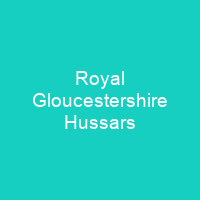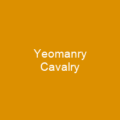The Royal Gloucestershire Hussars: A Regiment of Timeless Valor
Imagine a regiment that has stood the test of time, from its humble beginnings in 1795 to its valiant service during both World Wars. The Royal Gloucestershire Hussars, with its storied history and rich traditions, is such an institution. This article delves into the fascinating journey of this volunteer yeomanry regiment, exploring its origins, transformations, and contributions to British military history.
The Early Days: A Regiment Born in Turmoil
How did it all begin? The Corps of Gentlemen and Yeomanry, as it was initially known, was formed in 1795 during the height of the French Revolutionary Wars. These troops were meant to be a reserve force, ready to defend their homeland should the need arise. By 1798, eight troops had been raised, but most were disbanded after the Peace of Amiens in 1802. Yet, the spirit of these volunteers endured.
Adapting and Evolving: From Yeomanry to Imperial Yeomanry
The early 19th century saw a resurgence in the yeomanry’s role as threats from Napoleon loomed once again. By 1815, only one troop remained in Gloucestershire. The Royal Gloucestershire Hussars, as it was later named, adopted a hussar uniform and became part of the Imperial Yeomanry during the Second Boer War. This transformation from independent troops to a larger, more structured force reflects the changing nature of warfare.
The Great War: A Regiment in Action
During World War I, the Royal Gloucestershire Hussars saw action on multiple fronts. From the Gallipoli campaign to the Battle of Gaza and beyond, this regiment fought with distinction. The Battle of Katia, for instance, cost the regiment 98 casualties, a stark reminder of the human toll in war. Major Charles Turner’s Distinguished Service Order was well-deserved recognition for his leadership during the Battle of Romani.
World War II: A New Chapter
The Royal Gloucestershire Hussars re-emerged as an armoured regiment, serving in both training and combat roles. The 1st Royal Gloucestershire Hussars trained over 5,000 officers and men during the war years. In North Africa, they fought bravely but suffered significant losses. Lieutenant-Colonel Charles Birley’s command of the regiment was marked by valor and sacrifice.
Post-War Reconstitution: A New Era
The end of World War II brought a new chapter for the Royal Gloucestershire Hussars. In 1947, it was reconstituted in the reconnaissance role. The regiment’s battle honours include El Alamein, and its honorary colonels included Henry Somerset, 10th Duke of Beaufort, who served from 1926 to 1999.

The Royal Gloucestershire Hussars is a testament to the enduring spirit of volunteer service and the resilience of British military tradition. From its origins as a yeomanry regiment to its role in both World Wars, this regiment has played a significant part in shaping the history of the British Army.
The Royal Gloucestershire Hussars is more than just a name; it’s a legacy of courage and dedication. As we reflect on their contributions, let us remember the valor of those who served and the enduring spirit that continues to inspire future generations.
You want to know more about Royal Gloucestershire Hussars?
This page is based on the article Royal Gloucestershire Hussars published in Wikipedia (retrieved on November 29, 2024) and was automatically summarized using artificial intelligence.







